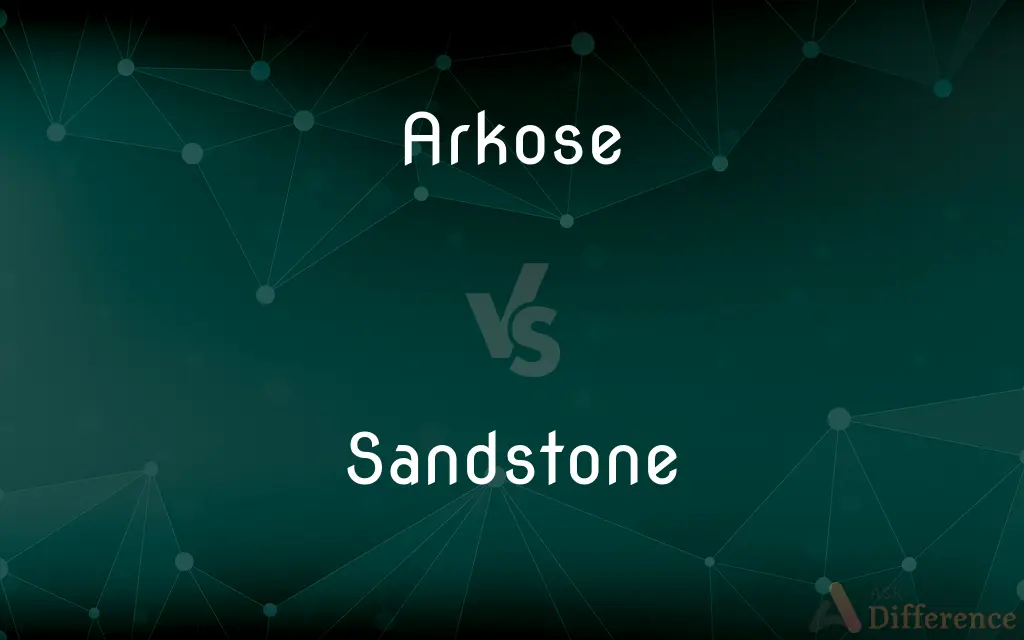Arkose vs. Sandstone — What's the Difference?
By Urooj Arif & Maham Liaqat — Updated on March 29, 2024
Arkose is a type of sandstone characterized by its high feldspar content, indicating proximity to its source rock, associated with semi-arid environments. Sandstone, broadly, is a sedimentary rock composed mainly of sand-sized minerals depends on source.

Difference Between Arkose and Sandstone
Table of Contents
ADVERTISEMENT
Key Differences
Arkose is recognized for its high feldspar content, typically more than 25%, which gives it a distinctive pink or reddish color due to the presence of orthoclase feldspar. This high feldspar content suggests rapid erosion and deposition, often near the original granite source rock, with minimal transport distance allowing the feldspar to remain without dissolving. Sandstone, on the other hand, has a more varied composition, including quartz, feldspar, and other minerals, reflecting a broader range of source rocks and depositional environments, from beaches to deserts and riverbeds.
The formation environment of arkose points to arid or semi-arid conditions where chemical weathering is minimal, allowing feldspar to accumulate. This contrasts with many sandstones, which are formed in environments where extensive transport and weathering can occur, leading to a higher quartz content as feldspar and other minerals are more likely to be broken down or dissolved during longer transport.
Arkose's grain size and sorting can be variable, but it is often coarse-grained and poorly sorted due to the rapid deposition of material from nearby source areas. In contrast, sandstone can range from fine to coarse grains, with the sorting and roundness of grains providing clues to the distance of transport and energy of the depositional environment.
The porosity and permeability of arkose can be affected by the matrix and cementing materials, which can include clay minerals that reduce its reservoir quality. Sandstone's porosity and permeability, however, vary widely, influenced by the degree of compaction, cementation, and the size and sorting of its grains, making some sandstones excellent reservoirs for groundwater and hydrocarbons.
Despite their differences, both arkose and sandstone share common sedimentary rock characteristics, including stratification and the potential to contain fossils. Yet, the specific conditions under which each forms arkose with its rapid erosion and deposition near source rock, and sandstone's broader array of formation environments highlight their distinct natures and the diverse processes that shape the Earth's surface.
ADVERTISEMENT
Comparison Chart
Main Composition
High feldspar content (often >25%)
Quartz, feldspar, and other minerals
Color
Typically pink or reddish
Varies widely
Formation Environment
Arid or semi-arid, near source rock
Diverse, including deserts, beaches, riverbeds
Grain Size & Sorting
Often coarse-grained and poorly sorted
Ranges from fine to coarse, variable sorting
Weathering
Minimal, preserving feldspar
Extensive, favoring quartz accumulation
Depositional Speed
Rapid, indicating minimal transport
Varies, can be slow or fast depending on environment
Use & Significance
Indicator of arid conditions and rapid erosion
Varied, depending on composition and formation environment
Compare with Definitions
Arkose
A type of sandstone rich in feldspar, indicating minimal transport from the source.
The pink arkose cliffs near the riverbank hint at the granite mountains nearby.
Sandstone
Found in a variety of environments, from deserts to beaches.
Sandstone formations dominate the landscape, from the desert dunes to the seaside cliffs.
Arkose
Characterized by its coarse grains and poor sorting.
The coarse, rugged texture of arkose makes it distinct from other sandstones.
Sandstone
Can vary widely in composition and color, depending on its source and formation conditions.
The varying shades of sandstone in the canyon walls create a stunning visual display.
Arkose
The high feldspar content gives arkose a distinctive coloration.
The reddish hue of the arkose layer adds a colorful accent to the landscape.
Sandstone
The grain size, sorting, and roundness indicate the rock's transport and depositional history.
The fine-grained, well-sorted sandstone suggests a long journey before deposition.
Arkose
Used in construction and as an indicator of geological processes.
Arkose, with its durability, is used in local construction projects.
Sandstone
A sedimentary rock composed mainly of sand-sized minerals or rock grains.
The ancient sandstone temple stands testament to the enduring nature of the material.
Arkose
Often found in arid environments due to its quick deposition and preservation of feldspar.
In the desert, arkose formations are common, showing the area's geological history.
Sandstone
Used in construction, decoration, and as reservoirs for water and hydrocarbons.
The porosity of sandstone makes it a vital aquifer for the region.
Arkose
Arkose () is a detrital sedimentary rock, specifically a type of sandstone containing at least 25% feldspar. Arkosic sand is sand that is similarly rich in feldspar, and thus the potential precursor of arkose.
Sandstone
Sandstone is a clastic sedimentary rock composed mainly of sand-sized (0.0625 to 2 mm) silicate grains. Sandstones comprise about 20–25% of all sedimentary rocks.Most sandstone is composed of quartz or feldspar (both silicates) because they are the most resistant minerals to weathering processes at the Earth's surface, as seen in the Goldich dissolution series.
Arkose
A usually pinkish or red sandstone consisting primarily of quartz and feldspar and forming from the cementation of particles generated by the rapid erosion of granite.
Sandstone
A sedimentary rock formed by the consolidation and compaction of sand and held together by a natural cement, such as silica.
Arkose
(geology) A sedimentary rock consisting of small fragments of feldspar and quartz similar to a coarse sand.
Sandstone
A sedimentary rock produced by the consolidation and compaction of sand, cemented with clay etc.
Arkose
A sandstone derived from the disintegration of granite or gneiss, and characterized by feldspar fragments.
Sandstone
A rock made of sand more or less firmly united. Common or siliceous sandstone consists mainly of quartz sand.
Sandstone
A sedimentary rock consisting of sand consolidated with some cement (clay or quartz etc.)
Common Curiosities
Why is arkose often pink or reddish?
The pink or reddish color of arkose is due to the presence of orthoclase feldspar, which is often abundant in its composition.
What distinguishes arkose from other types of sandstone?
Arkose is distinguished by its high feldspar content, often greater than 25%, and its association with rapid deposition near the source rock, typically in arid environments.
What makes sandstone a good reservoir for groundwater and hydrocarbons?
Some sandstones are excellent reservoirs due to their high porosity and permeability, which allow for the storage and movement of fluids.
Are there specific uses for arkose in construction or other industries?
Arkose is used in construction, particularly in regions where it is abundant, due to its durability and aesthetic properties, and it can also serve as an indicator of past geological processes.
Can the environment of formation affect the characteristics of sandstone and arkose?
Yes, the environment of formation significantly influences the characteristics of these rocks, with arkose forming in arid or semi-arid conditions and sandstone forming in a broader range of environments.
Why is weathering important in distinguishing between arkose and other sandstones?
Weathering plays a crucial role in distinguishing arkose from other sandstones because it affects mineral composition; arkose shows minimal weathering, preserving its high feldspar content, while more weathered sandstones have higher quartz content.
How does the grain size and sorting of arkose compare to that of sandstone?
Arkose is often coarse-grained and poorly sorted due to rapid deposition near the source, while sandstone can range from fine to coarse grains with variable sorting.
How do the porosity and permeability of arkose and sandstone differ?
Arkose's porosity and permeability can be lower due to clay minerals in the matrix, whereas sandstone's vary widely, influenced by grain size, sorting, and cementation.
What is the significance of a rock's composition, such as the feldspar content in arkose?
A rock's composition, such as the feldspar content in arkose, can reveal information about the rock's source, the conditions of its formation, and the environment at the time of its deposition.
Can the color of sandstone vary, and what does it indicate?
Yes, the color of sandstone can vary widely, indicating different mineral contents and environmental conditions during its formation.
Share Your Discovery

Previous Comparison
Jumper vs. Hoodie
Next Comparison
Grenadilla vs. GrenadilloAuthor Spotlight
Written by
Urooj ArifUrooj is a skilled content writer at Ask Difference, known for her exceptional ability to simplify complex topics into engaging and informative content. With a passion for research and a flair for clear, concise writing, she consistently delivers articles that resonate with our diverse audience.
Co-written by
Maham Liaqat















































